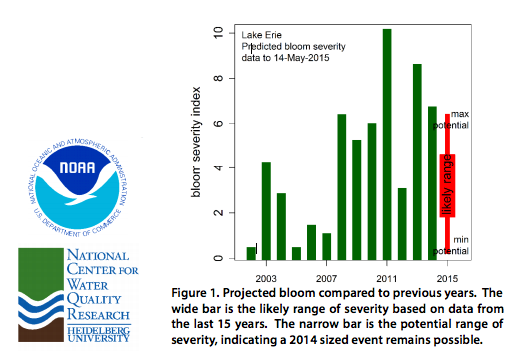Lake Erie Toxic Algae Expected to be Worse this Year
 The National Oceanic and Administration (NOAA) predicts that Toxic Algae on Lake Erie to be worse than last year and attributes the growth to the heavy precipitation during the first half of 2015. On 10-point scale, NOAA estimates the algal bloom will range from 8.1 to 9.5; a severity above 5.0 is considered of high concern. Last year, the bloom was rated a 6.5, which was severe enough to force more than 400,000 in the Toledo area to go without water for several days. Last year, beaches were closed across the Lake all the way to Pelee Island in Canada.
The National Oceanic and Administration (NOAA) predicts that Toxic Algae on Lake Erie to be worse than last year and attributes the growth to the heavy precipitation during the first half of 2015. On 10-point scale, NOAA estimates the algal bloom will range from 8.1 to 9.5; a severity above 5.0 is considered of high concern. Last year, the bloom was rated a 6.5, which was severe enough to force more than 400,000 in the Toledo area to go without water for several days. Last year, beaches were closed across the Lake all the way to Pelee Island in Canada.
In response to the 2015 Lake Erie Algae Forecast, Jen Miller, Director of Sierra Club Ohio, stated the following:
“The combination of unsustainable agricultural practices and climate change is a double whammy for Lake Erie and water systems statewide. With more severe rain events and flash flooding, fertilizer and manure is oozing off of farms and into out our watersheds, which is threatening clean water resources and public health.
Governor Kasich and the Ohio General Assembly need to do more. Legislation passed this spring, Senate Bill 1, only placed limits of agricultural run-off during the winter. As we see increasingly wet springs and summers because of climate change, farm run-off needs to be regulated year-round.
Given that water quality issues are not just plaguing Lake Erie but also Buckeye Lake, Grand Lake St. Mary, Hoover Reservoir, and waterways statewide, clean water protections need to be enacted statewide.
The public also deserves the assurance that their tap water is safe, and currently testing for microcystin, a toxin found in cyanobacteria, is only voluntary. Testing for all toxins associated with animal and human waste and toxic algae should be made mandatory for public drinking water providers in Ohio.
At Sierra Club Ohio, we believe all Ohioans deserve swimmable, drinkable, fishable water all year-round.
So Where Do These Chemicals Come From?
- Farm Fertilizer Run-Off
- Livestock Manure Run-off
- Human Raw Sewage Overflows From Cities’ Aging Combined Sewer Infrastructure
- Lawn and Garden Fertilizer Run-Off
- Internal existing lake loads of phosphorus and nitrogen, that get resuspended through natural or human impacts
What can YOU do to help?
- Join Sierra Club’s Ag & Water Committees to help drive policies and actions towards solutions to toxic algae in Ohio and Lake Erie
- Become trained in Citizen’s Water Monitoring, otherwise known as Sierra Club Water Sentinels. Water Sentinels raise the first red flags so that the proper agency can research the problem.
- Become trained in WARN (Water Alert Reporting Network) from the Sierra Club. This program teaches citizens how to visually identify and properly report water contamination incidents.